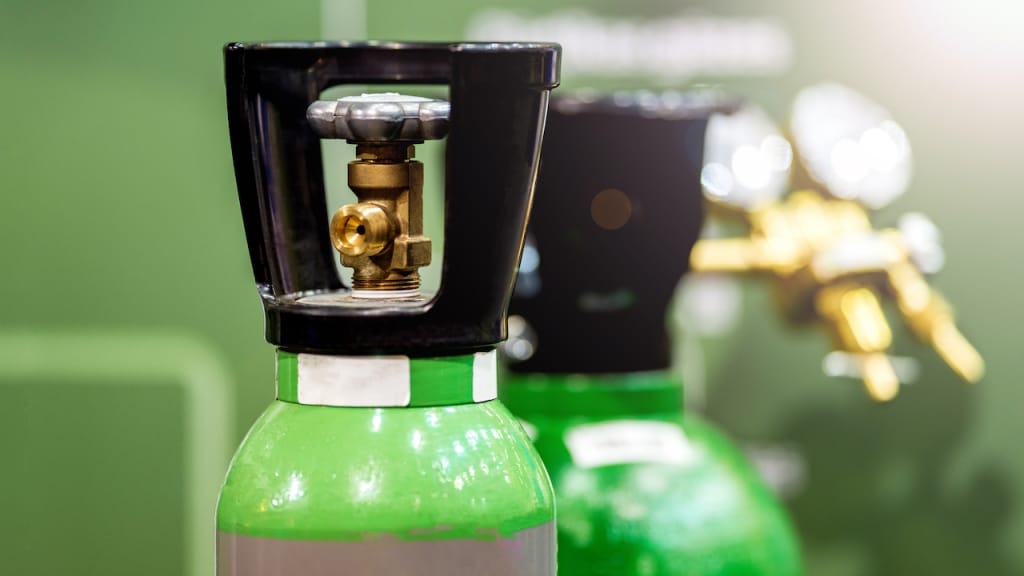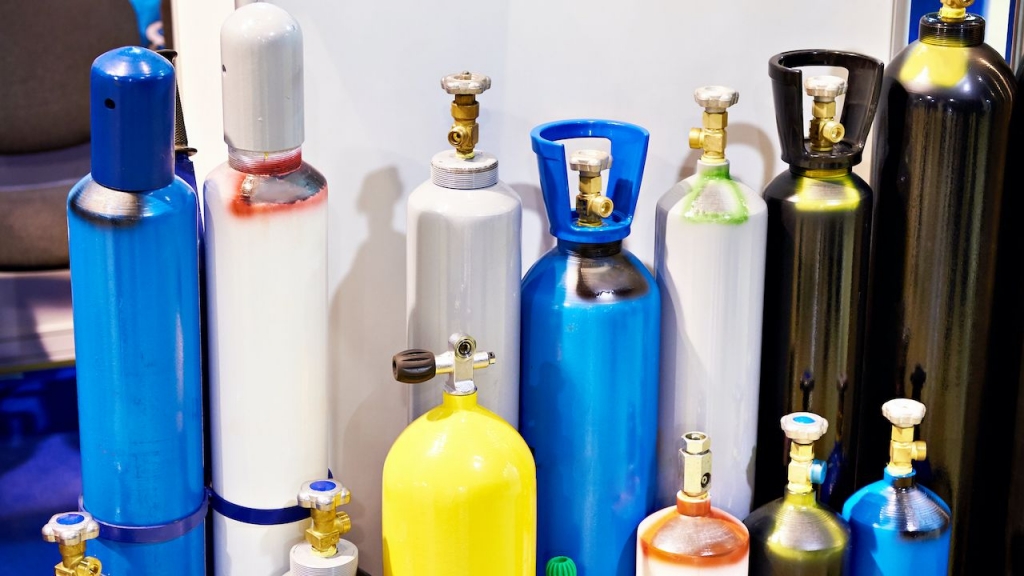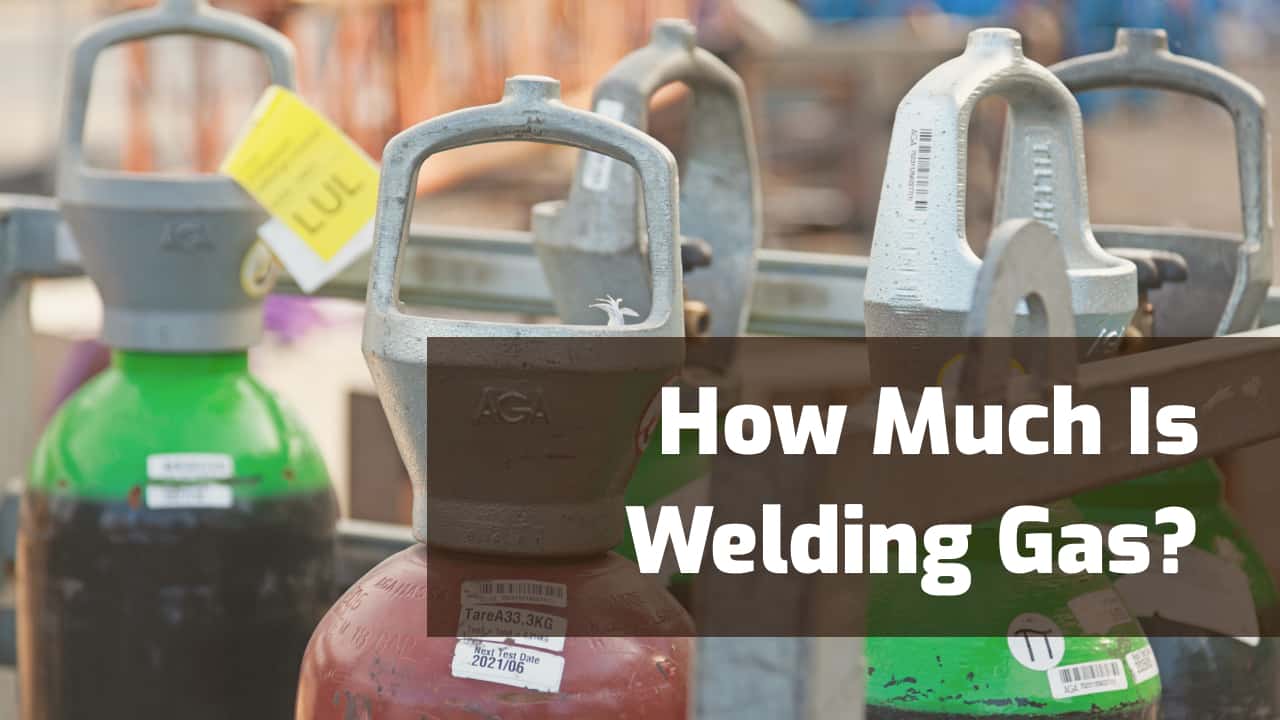Welding gas costs depend on your cylinder size and the specific gas or blend. Plus, you may need gas for shielding your welds or as an oxy-fuel for flame welding and cutting.
As you can see, determining welding gas costs is far from straightforward. But, don’t worry. This article answers all of your questions and can help you estimate your total welding gas costs.
The Cost of Welding Gas
Before proceeding to gas tank sizes and the different methods of acquiring a gas bottle, let’s quickly recap some of the most common welding gasses you may need.

Common Welding Gasses
- Argon (Ar) – Argon is an inert shielding gas primarily used with TIG welding. But, if you wish to MIG weld aluminum, it’s necessary to use a 100% Ar shielding gas.
- Helium (He) – Like argon, helium is an inert gas most often used in an argon/helium mixture. The higher the helium content, the deeper the penetration. So, helium is often used to maximize the metal thicknesses you can work with on your TIG welder.
- Carbon dioxide (CO2) – CO2 is a reactive gas, and you cannot use it to TIG weld. However, if blended with argon, CO2 does a great job stabilizing the arc when MIG welding mild steel. The most common mixture is 75% Ar and 25% CO2. Similar to helium, CO2 improves penetration when MIG welding. The higher the CO2 content, the deeper the penetration. Often, hobbyists use a pure CO2 shielding gas for MIG welding mild steel because it’s inexpensive. But, if argon isn’t present in the mixture, you will experience more spatter and erratic arc behavior.
- Oxygen (O2) – Oxygen is sometimes used in a mixture with argon as a shielding gas for welding stainless steel, but oxygen content must be less than 9%. That’s because oxygen is highly reactive. It can oxidize the weld pool and tarnish weld quality. But, when oxy-cutting or welding, oxygen aggressively amplifies the flame heat. Oxygen is used with acetylene in oxy-acetylene cutting and welding processes to achieve the hottest flame. But, propane and propylene are also used as oxy-fuel.
- Acetylene (C2H2) – Acetylene is the top choice for oxyfuel welding since acetylene creates exceptional heat when burning with oxygen.
Above are the most commonly used gasses for welding and cutting metal. But, there are many other less often used gasses and blends. You can learn everything about different welding gasses in our complete guide for information on more specialized gas.
Tank Cost
Before discussing the prices of the individual gasses, we need to address the cost of the gas tank itself. The price of the gas bottle depends on its size, the form of ownership, and whether it’s refillable or disposable.
Common Sizes

Gas distributors sell various tank sizes, but the three most commonly available are 40, 80, and 125 cubic feet (“CF”). Hobbyists should consider 40 CF and 80 CF sizes, while 125 CF is more appropriate for demanding welders.
Refer to our in-depth guide If you wish to learn more about different welding gas tank sizes. But, here is a list of the common sizes you are likely to find on the market:
- Size R – 20 CF
- Size V – 40 CF
- Size Q – 80 CF
- Size S – 125 CF
- Size K – 200 CF
- Size T – 300 CF
If you buy a tank too small, you’ll need to make frequent trips to your local gas supplier for refills. Unless you live nearby, the transportation costs and downtime add up. So, ensure that you get a big enough bottle for your needs.
There are a few downsides to getting a larger tank too. They have a higher initial cost, are challenging to transport, and take up more of your valuable storage area.
Rent vs. Buy
There are two ways to acquire refillable gas tanks: buying or renting. Leasing a gas tank is cheaper short term, but it’s significantly more expensive after a couple of years. Big welding shops usually rent gas tanks to avoid a large upfront investment. But, if you are a hobbyist, it’s more cost-effective to buy a new cylinder.
If you rent the tank, you must pay a yearly fee and the refills or an exchange with a freshly filled tank. But, if you own the tank, you just need to pay for a refill. Below are the most popular welding gasses sold with a full bottle to give you a price estimate.
100% Argon Gas Tank Costs
75% Argon / 25% CO2 Tank Costs
100% Oxygen Tank Costs
| Size | Initial Cost |
|---|---|
| 40CF | $240 to $270 (full tank) (example) |
| 80CF | $255 to $300 (full tank) (example) |
| 125CF | $380 to $450 (empty tank) (example) |
100% Acetylene Tank Costs
| Size | Initial Cost (empty) |
|---|---|
| 40CF | $140 to $180 (example) |
| 75CF | $300 to $400 (example) |
| 145CF | $450 to $550 (example) |
Disposable Tanks
Disposable tanks are handy if you need a small amount of welding gas or if you weld on the go. But, this is the most expensive way to obtain your shielding gas.
While it’s cheaper to buy a tiny disposable gas tank, the gas can be 15 times cheaper if you refill a large tank like 125 CF.
Refill Expense
You must refill the gas bottle after your purchase unless the shipped tank is full. But, even if that’s the case, the gas will run out. So, let’s review the typical prices for different welding gas refills.
As you can see from the table below, the refill price is not much higher as the volume of the gas increases. The gas itself is pretty cheap, and it takes as much labor to fill a large tank as a small one. So, it’s far more cost-effective to own a larger tank.
| Size | 100% Argon | 75% Argon / 25% CO2 | 100% Oxygen | 100% Acetylene |
|---|---|---|---|---|
| 40CF | $45 to $60 | $45 to $60 | $40 to $45 | $60 to $65 |
| 80CF | $55 to $65 | $55 to $65 | $45 to $50 | $65 to $70 |
| 125CF | $70 to $85 | $70 to $85 | $55 to $60 | $110 to $130 |
Note: these are a guideline only and gas prices do fluctuate.
How to Calculate the Real Cost
To estimate the total amount, we need to look at the gas tank price and the refill cost. It’s best if we do this with real-world examples. But, keep in mind that the prices may fluctuate as the industrial gas market constantly changes. Plus, some gas suppliers have higher prices. So, always check with a few local gas dealers to see if you can get a better deal for the refill.
If you plan to TIG weld, you’ll need an argon tank. So, let’s assume you’ll buy an 80 CF gas bottle and refill it once every two months. That’s $300 for the bottle and $60 for the refill. So, the total cost is about $660 for the first year and then $360 annually after that.
Related: Best Gas for TIG Welding
You can use either an Ar/CO2 mix or 100% CO2 to MIG weld. But, let’s calculate the costs for the argon and carbon dioxide mixture since it’s the most common. A 125 CF gas tank costs about $360, and the refill is roughly $70. If you refill it once every three months, you’ll pay about $640 in the first year and then about $280 annually.
Related: MIG Welding Gases – What to Use
If you wish to do flame welding or cutting, you must buy oxyacetylene and oxygen gas tanks. Let’s calculate this example with 40 CF bottles. An oxygen gas tank costs $250, and its refill is about $40. An acetylene tank costs $150, with a refill cost of $60. If you refill the tanks once every six months, the first year will cost you $750, and every year after that, $200.
How Long Will Welding Gas Last?
Divide the cylinder volume by the gas flow rate to calculate how long your welding gas tank will last. For example, an 80 CF gas tank with a flow rate of 10 CFH (cubic feet per hour) will last about 8 hours.
The flow rate you use depends on the welding process, joint width, whether the joint has a root opening, whether you are welding indoors or outdoors, etc. But, the most common flow rate is between 10 CFH and 40 CFH. We wrote about this extensively in our gas tank sizes guide if you want more information and setting your gas flow rate.
How Do I Know When I Need Gas?
It’s easy for you to estimate the amount of gas left in the tank. A full gas bottle has a pressure of about 2015 psi. The pressure gauge shows this value on the regulator. As you use the gas, the pressure drops accordingly. For example, if the gas is 50% spent, the pressure gauge reads 1000 psi.
So, once the pressure gauge needle starts getting close to zero, it’s time for a refill. However, it’s not a good idea to completely discharge the welding tank because this may lead to moisture contamination on the inside.
If you use 100% CO2 gas, it’s impossible to tell the pressure by observing the gauge. The CO2 bottles don’t use the same regulator as other welding gasses, and the pressure inside remains constant until the bottle is almost empty. Unlike other gasses, CO2 inside a pressurized tank is liquid, and the pressure over the liquid remains constant until the CO2 is gone. So instead, you’ll have to measure the weight of the gas tank. Check the specification sheet for the bottle you have for weight data when the tank is full or empty.
Does Welding Gas Go Bad?
Welding gasses do not go bad, but they can separate if your store gas mixtures for too long. If this happens, a simple solution is to lay the gas bottle horizontally and gently roll it back and forth. Be extra careful not to damage the tank valve because this will send the tank flying like a missile. Make sure you understand pressurized gasses hazard prevention before doing anything unorthodox.
Where to Buy or Refill Your Gas
We recommend the gas tanks previously linked in the pricing tables. It’s easiest to order shielding gas tanks online. But, you can also buy them in person at your local gas dealer.
However, most gas providers lease and refill tanks. It’s rare to find gas bottles for sale. So, either order it online or find a local dealer selling gas tanks like Northern Tool or AirGas.
Wrapping It Up
Welding gasses are not expensive after making an initial investment in a gas tank. However, getting the right gas cylinder size is critical. If in doubt, get a larger bottle unless you do a lot of welding on the go.
Some welders skip shielding gasses altogether by using a self-shielded flux-cored wire instead of solid wire when MIG welding. Stick welders also don’t need a shielding gas. So by using different equipment, you can avoid getting a cylinder. But, more often than not, the MIG and TIG welding processes are preferable to FCAW and stick welding.
